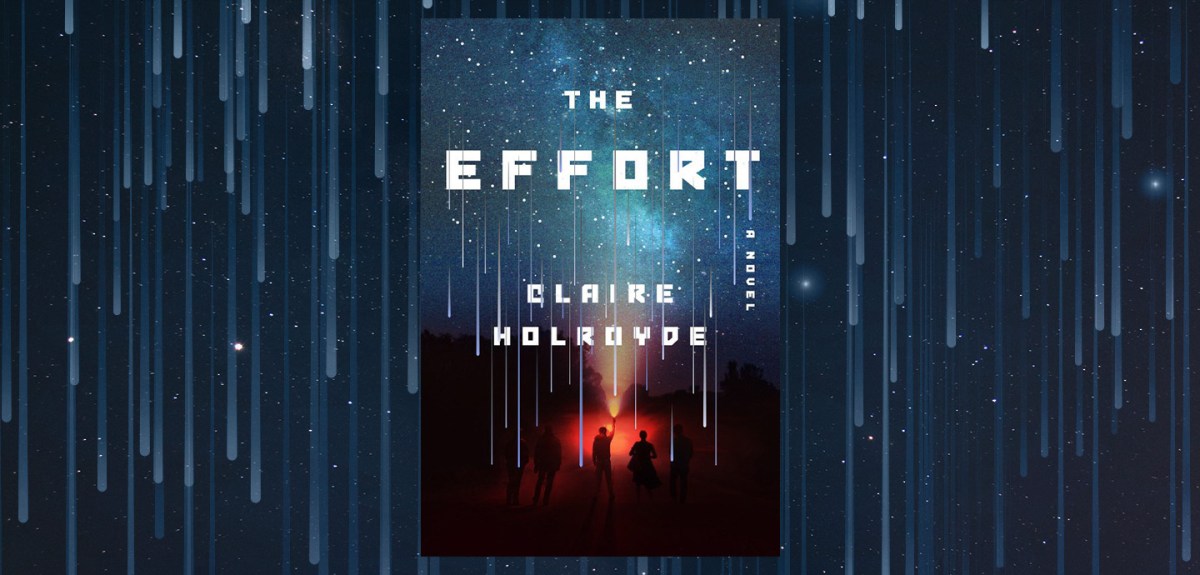[ad_1]
Our civilization has always had a precarious grasp on existence, although between the pandemic and the climate-induced natural disasters of the past year, collapse feels a bit more imminent. Claire Holroyde would like to add another fear to our anxiety: dark comets. In her debut novel, The Effort, a comet large enough to extinguish human life on the planet is discovered approaching on a collision course at high speed. From the first pages of the book, Holroyde takes us on an engaging examination of how we as a civilization respond to such a crisis. The Effort paints a bleak picture of humanity’s final days, but ultimately offers a message of hope; our survival relies on exploiting the most fundamentally human trait—connecting and trusting one another.
The book opens with the discovery of a dark comet, an object invisible to observation from earth’s perspective, entering a viewable point in the sky only when dangerously close to impact. The story follows a global effort to deflect the comet, starting when Dr. Ben Schwartz and his girlfriend Amy are whisked away to an equatorial command center. Their goal is to launch a vehicle into space and detonate a bomb, splitting the comet, before it strikes earth and decimates civilization. A second narrative follows the crew aboard the Healy, an arctic exploration vessel on its final voyage. Jack, a photographer, is on assignment to document the changes due to warming temperatures, and is joined by numerous scientists studying the effects.
The parallel narratives allow Holroyde to confront two disasters: the fictional comet and the very real threat of climate change. The world pours enormous sums of money and resources into the effort to stop the comet, while doing little to prevent climate change. Yet the Healy’s mission to study climate change in the arctic is entering its final expedition because of budget cuts. Climate change is no less a threat than the comet—Jack sees dead eagles as he embarks on the boat, a portent to our own fate. Yet, no expense is spared to fund the Effort, the name of the program to stop the comet. By weaving together a narrative about an arctic vessel studying the damage created by imminent climate change alongside the Effort to stop the comet, Holroyde draws a parallel between these two disasters. Ben, at the Effort, reflects on how a comet changed the planet’s ecosystems and led to the extinction of the dinosaurs. Meanwhile, Jack reflects on his mission to document the arctic, “an ecosystem already slipping from existence.” It seems from Holroyde’s perspective, the planet is doomed either way, but politicians are willing only to address the immediate threat of the incoming comet.
The novel has a broad scope, and diverse characters representing every continent, and many different cultures. Many of these people are only briefly introduced, and sideline narratives follow these tertiary characters adding to the details of the world. They have rich backstories, and though we may only glimpse at their lives, we learn enough to care about them. These side narratives are connected to the main protagonists—family and friends—but primarily exist to better shape our perception of the world. These side narratives also serve to balance the pacing of the novel, drawing out the narrative time to better represent the passage of weeks and months.
Holroyde isn’t shy about killing off her characters. On the Healy, suicide becomes common. On the mainland of the United States, enemies lurk everywhere as food shortages and the American love affair with firearms proves a deadly combination. The Effort isn’t immune and even these characters face starvation and a form of post traumatic stress disorder that leaves many comatose. When the staff of the Effort are no longer valuable, they are asked to leave the UN protected compound, an almost certain death sentence. These deaths create a refreshing sense of risk. Nobody is safe.
Once news of the approaching comet becomes public knowledge, civilization quickly falls apart. Governments fail. Supply lines collapse. The crumbling of civilization adds another challenge to the Effort. The scientists faced a monumental task, but the chaos caused by these disruptions adds to the uncertainty.
Meanwhile, the crew on the Healy experience the very opposite. The self-sufficient boat doesn’t need the outside world for months, and because of limited line-of-sight with satellites, the crew is cut off from the constant information stream covering the globe. The isolation of the Healy provides a balancing contrast to the focus on the effort, and Holroyde’s narrative structure works well to control pacing. The Effort serves as the center of humanity’s hope to survive, while the crew of the Healy is totally detached to the ongoing crisis. The members of the Healy expedition aren’t suffering from the fall of civilization, but they are cut off from their loved ones.
Holroyde leans heavily into science and contemporary technology to augment the novel’s verisimilitude. The Effort reflects science-focused research and avoids flimsy plots, like those in Michael Bay’s 1998 Armageddon, or far-flung science-fiction magic. The characters themselves acknowledge a deus ex machina device might be necessary to save the effort, but Holroyde cleverly finds an exit strategy anchored in reality. The Effort does not lead up to an action sequence denouement. It is, instead, a cerebral endeavor, grounded on planet earth. The Effort is a political novel rather than an action space adventure. The real crisis is not the incoming asteroid, but humanity itself, and the reaction to the threat of imminent death.
The Effort presents an optimistic view of humanity as a species on trial for its survival. Even as civilization breaks down, the experience of many of the characters feels hopeful, even upbeat. Humans find a connection with each other even in the worst of circumstances. The collapse of institutions depicted in the novel is unlike our current crisis of backlogged packages or toilet paper shortages—the collapse is far more total. To survive, the characters connect with each other, relying on empathy and trust. Their survival depends on that humanity, on working together.
Holroyde also delicately addresses the current American political crisis. Trump isn’t named, but his personality is evidenced by the actions and ineffectiveness of the American administration. When the comet’s trajectory toward earth is revealed, the American president Tweets, “My own scientists are working on it. Ignore the dishonest media. Stay Calm!” Holroyde is without a doubt alluding to Donald Trump, but without naming him.
The novel has a grand scope, but the characters earn our sympathy through complex and detailed backstories, even the minor characters. These details justify their motivations, adding to the plausibility. There are multiple protagonists throughout the expansive novel, but a few stand out as particularly empathetic. Early on, we’re introduced to Amy, the girlfriend of the lead scientist. Although she lacks the technical sophistication and education of many of the physicists and scientists at the effort, her grit means she continually reinvents herself and carves out a place for herself to remain relevant. In the Healy plotline, Jack ends up courting Maya Gutiérrez, a scientist skeptical of his advances. Their romance, particularly in the face of imminent death, grounds the novel in emotion. The Effort is ultimately a novel about the desire to live. Struggle is everywhere, on the individual level and in the broader sense as a species. Working together is proven essential. In the end, Holroyde has faith in an intangible human condition: survival depends on our willingness to help each other, and that quality allows humanity to thrive through adversity.

FICTION
The Effort
By Claire Holroyde
Grand Central Publishing
Published on January 12, 2021
[ad_2]
Source link
